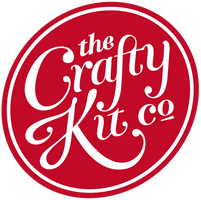
Like it or not, face masks are here to stay for some time to come, but they needn't be dull-looking. If you would like to make your own face coverings, follow our step by step guide below. They can be hand or machine sewn, and even kids can have a go!
Please note, these face coverings are not medical grade and do not make any health claims.
Items you'll need:
- 4 pieces of cotton fabric
- Sewing thread
- Sewing needle
- 2 metres of soft elastic
- Sharp scissors
- Plates or bowls of the correct diameter
- Pencil
- Ruler or tape measure
- Safety pin or paper clip
Or you can purchase everything you'll need with our Make Your Own Face Coverings Kit!
Step 1:

Draw a circle on the wrong side of the fabric using a pencil. The best template to draw around is a dinner plate or large bowl. Choose from these sizes:
ADULT: 10” to 12” or 25cm to 30cm diameter
TEEN: 9” or 23cm diameter
CHILD: 8” or 20cm diameter
Step 2:

Cut out the circle. If you would like to make a reversible face covering, you’ll need to cut two circles of the same size in different fabrics, as shown in our picture. Otherwise, you’ll just need one circle of fabric in one pattern.
Step 3:

Fold the circle in half, and half again to make a quarter circle.
Step 4:

With sharp scissors, cut along all the folded edges of the fabric to make 4 separate quarters. Picture 4 shows four quarters in two different fabrics to make 2 reversible face coverings.
Step 5:

Place the quarters in two piles, with the right sides of the fabric together, facing inwards.
Step 6:

With a small running stitch (or a sewing machine if you have one) and a
doubled length of thread, sew around the curved edges of each pair of quarters,
about 5mm in from the edge.

Make sure to start and end with a knot, or several stitches sewn one on top of the other, to keep your stitching secure.
Step 7:

Turn one stitched piece of the face covering round the right way and press with an iron. Lay the other half of the face covering on top, so that both pieces are right sides together.
Step 8:

Stitch along the top and bottom of the face covering, leaving a gap of around 2cm at each corner. Again, make sure to start and end with a knot, or several stitches sewn one on top of the other, to keep your stitching secure.
Step 9:

Turn the face covering the right way round. This is a fiddly job; start by pulling a little fabric through one of the holes on the corner. Keep pulling the fabric through, a little at a time until the face covering is the right way round.
Step 10:

Turn out the corners of the face covering, creating points. Iron the face
covering, taking care to roll out and press out the seams.
Step 11:

Fold over one corner of the face covering by about 1cm. Press this down with an iron. Fold over again by about 1cm and press down firmly. This creates the channel for the elastic. Repeat this step on the other corner.
Step 12:

With a double thickness of thread, stitch down the channel using an oversewing stitch.

Make sure to start and finish by stitching a few stitches on top of each other.
Step 13:

Cut the elastic. You’ll need the following measurements, cut twice.
Please note that before cutting the elastic, you should try the face covering for size and measure the distance from the face covering to your ear. Ideally you want to cut a little more elastic than you need to prevent the face covering being too tight and hurting your ears.
ADULT: 9” or 23cm
TEEN: 8” or 20cm
CHILD: 7” or 18cm
Step 14:

Thread the elastic through the channels. The easiest way to do this is to attach a small safety pin or paper clip to one end of the elastic and push the safety pin or paper clip through the channel. The elastic will follow.
Step 15:

Tie the ends of the elastic in a tight knot. If possible, try for size first. Move the elastic so that the knot is hidden inside the channel.
Stay safe and carry on crafting! Please share your face coverings with us - find us on Facebook, Instagram, Pinterest, & Twitter!
Enjoying our blog posts? Join our mailing list to receive every new post straight to your inbox!
At The Crafty Kit Company we hate spam, we never share data and you can unsubscribe from our mailing list at any time.

Comments
Rebecca:
Hi Maya,
Thank you very much for the feedback, which we really appreciate!
:-)
With best wishes,
Rebecca @ The Crafty Kit Company
Nov 23, 2020
Maya:
Thank you for printing these instructions here. I hope you don’t mind me giving some feedback on this.
Step 5 would be clearer if it was pointed out that the right sides were on the inside.For people who don’t sew often I have been told:
It is difficult to keep the frayed edges inside the corners, after turning.
( Some people don’t even have access to an iron). I have advised that they leave the gap on one of the straight edges instead. This keeps the corners neat and makes it easier to turn in and oversew.
I do appreciate all you have done.
Thank you,
Maya
Nov 23, 2020
Leave a comment